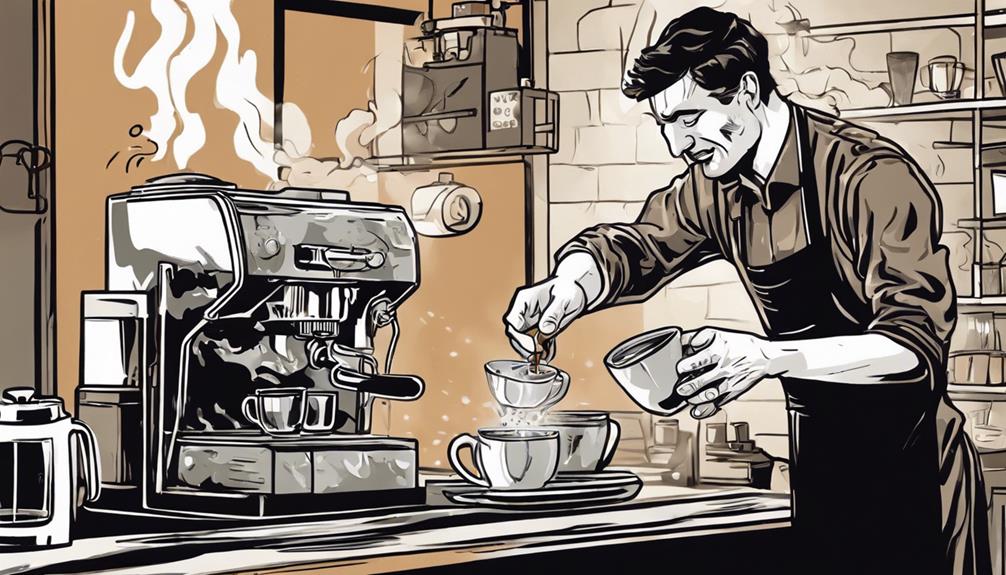To safely burn coffee, make sure to keep the grounds away from flames and ensure good ventilation. Use a heat-resistant container on a stable surface and have a fire extinguisher nearby for added safety. Following these guidelines will allow you to safely burn coffee for pest control or other purposes. If you have any doubts or concerns about burning coffee, it is recommended to consult with a professional. When it comes to brewing coffee like a pro, having the right tools and knowledge is essential to achieving a quality end result. By taking safety precautions and seeking guidance, you can confidently utilize coffee for various purposes, such as pest control, while also mastering the art of brewing coffee like a pro.
Key Takeaways
- Use a heat-resistant container for burning coffee grounds.
- Ensure proper ventilation to prevent smoke buildup.
- Keep grounds away from flammable items.
- Supervise burning process at all times.
- Have a fire extinguisher nearby for safety.
Safety Precautions for Burning Coffee
To burn coffee grounds safely, keep them away from open flames to prevent accidental fires. Safety precautions are important when engaging in this process.
Make sure you have proper ventilation to avoid inhaling smoke from the burning coffee grounds. Use a heat-resistant container placed on a flat surface to contain the burning grounds securely.
Always have a match or lighter at hand before starting the burning process. Following these safety measures diligently is vital to prevent burns or other accidents while burning coffee.
Proper Ventilation and Fire Safety
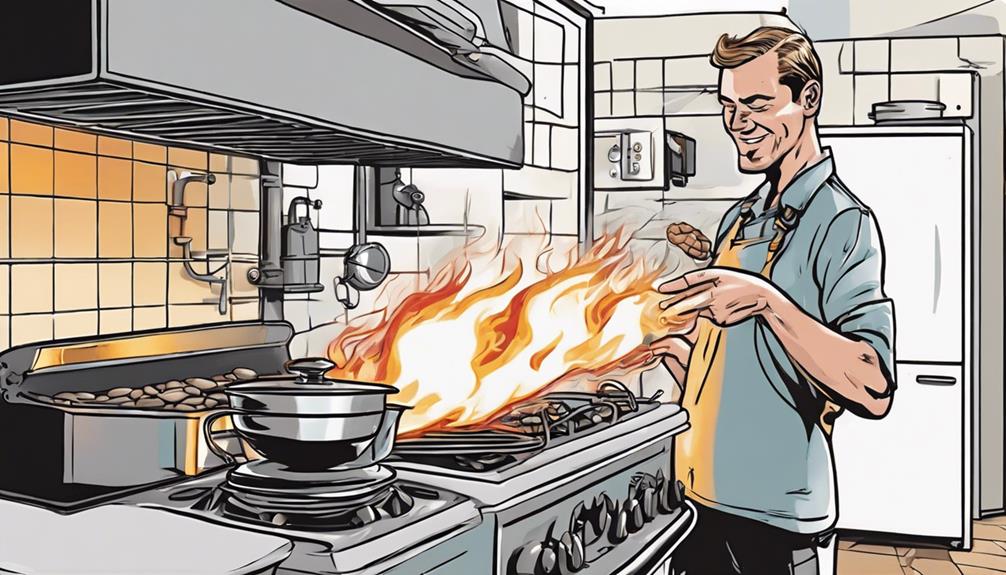
You need to prioritize proper ventilation when burning coffee to prevent smoke buildup and maintain air circulation. Make sure to open windows or use fans for improved airflow and a safer burning environment.
Following fire safety guidelines and practicing safe burning practices are essential for a secure coffee burning experience. To ensure a safe burning experience, it is important to keep flammable materials away from the coffee burner and always have a fire extinguisher nearby. Additionally, make sure to properly dispose of used coffee grinds and clean the burner regularly to prevent any build-up that could increase the risk of a fire. By following these safety guidelines, you can enjoy the aroma and warmth of freshly roasted coffee without having to worry about potential hazards. Remember, following these precautions is the best way to avoid burnt coffee and keep your brewing experience enjoyable and safe.
Ventilation Importance
Proper ventilation plays a critical role in ensuring fire safety when burning coffee grounds. When you burn coffee grounds, having adequate ventilation is essential to prevent the accumulation of harmful fumes and maintain a safe environment. Good airflow helps disperse smoke, reducing the risk of carbon monoxide poisoning and minimizing indoor air pollution. Lack of ventilation can result in smoke inhalation, respiratory problems, and potential fire hazards, underscoring the necessity of well-ventilated spaces for burning coffee grounds safely.
To emphasize the significance of ventilation in burning coffee grounds, consider the following key points:
| Importance of Ventilation | Effects |
|---|---|
| Prevents buildup of harmful fumes | Minimizes health risks |
| Disperses smoke effectively | Reduces carbon monoxide poisoning |
| Maintains healthy breathing space | Prevents indoor air pollution |
Fire Safety Guidelines
Maintain a safe environment by ensuring proper ventilation and following fire safety guidelines when burning coffee grounds. To burn coffee grounds safely, it's essential to have adequate ventilation. Burn the grounds in an open area or near a window to prevent smoke buildup, reducing the risk of inhaling harmful fumes. Additionally, keep the coffee grounds away from open flames or flammable materials to minimize fire hazards. When burning coffee grounds, opt for a heat-resistant container such as a ceramic dish or metal tin to contain the ashes safely.
For fire safety, always place the container on a level and stable surface to avoid accidental spills or tipping over. Remember to supervise the burning process at all times and never leave it unattended. By adhering to these fire safety guidelines, you can enjoy burning coffee grounds safely while minimizing the risk of accidents or fire hazards.
Safe Burning Practices
To prioritize safe burning practices when burning coffee grounds, prioritize proper aeration and fire safety measures. Securing adequate ventilation helps prevent the accumulation of harmful smoke and fumes. Additionally, keeping the burning coffee grounds away from flammable materials and open flames markedly reduces fire hazards. Using a heat-resistant container or surface to contain the burning coffee grounds is essential for safety. Avoid burning coffee grounds in enclosed spaces to prevent the risk of carbon monoxide buildup, which can be perilous. Always have a fire extinguisher or water source nearby as an added safety precaution in case of emergencies. Prioritizing safe burning practices is crucial not only for fire safety, but also for preventing burnt coffee. Monitoring the burning process closely and adjusting the heat as needed can help avoid scorching the coffee grounds. Implementing these safety measures ensures a more controlled and enjoyable burning experience while preventing burnt coffee.
| Safe Burning Practices | Tips for Safety |
|---|---|
| Proper Aeration | Ensure smoke and fumes are adequately dispersed to prevent health risks. |
| Fire Safety Measures | Keep burning coffee grounds away from flammable items and have extinguishing tools nearby. |
Materials Needed for Burning Coffee Grounds
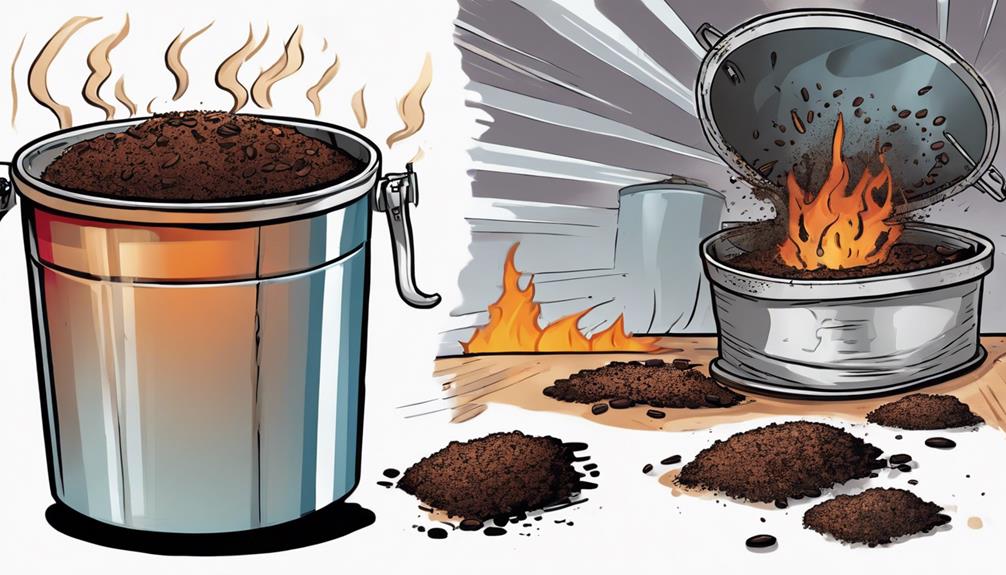
For burning coffee grounds safely, you'll need a heat-resistant container to hold the grounds during the burning process. Dry coffee grounds are necessary for this purpose as they ignite more easily and yield better results.
Additionally, you'll require a match or lighter to ignite the coffee grounds within the heat-resistant container. Proper ventilation is essential throughout the burning process to prevent smoke buildup and guarantee safety.
It's also important to use a level surface for burning the coffee grounds to maintain stability and reduce the risk of accidents. By having these materials on hand and following these steps, you can safely burn coffee grounds for various purposes.
Remember to prioritize safety at all times and enjoy the benefits that come with this eco-friendly practice.
Coffee Grounds for Pest Control

Enhance your pest control efforts by utilizing coffee grounds to repel insects. Dry out used coffee grounds to create a natural and effective insect repellent through burning and strategic placement.
Coffee grounds contain caffeine and diterpenes, acting as natural insecticides that make them a potent pest control option. Burning coffee grounds near windows can deter insects from entering your home, providing a chemical-free solution to keep pests at bay.
For enhanced effectiveness, consider mixing coffee grounds with cloves and bay leaves to further boost their insect-repelling properties. Position the burning coffee grounds strategically around your living spaces to repel pests effectively.
Enhancing Insect-Repelling Properties

Consider incorporating additional natural elements like cloves and bay leaves to enhance the insect-repelling properties of coffee grounds for more effective pest control.
Bay leaves, known for their aromatic properties, can serve as a potent mosquito repellent when combined with coffee grounds. By crushing bay leaves and mixing them with coffee grounds, you can create a powerful blend that enhances the control of insects in the surrounding area.
The addition of cloves further complements the natural insect-repelling properties of coffee grounds, increasing their effectiveness in repelling pests. Mixing these ingredients can amplify the insect-repelling power of the grounds, providing a more robust solution for pest control.
Placement and Application for Pest Control
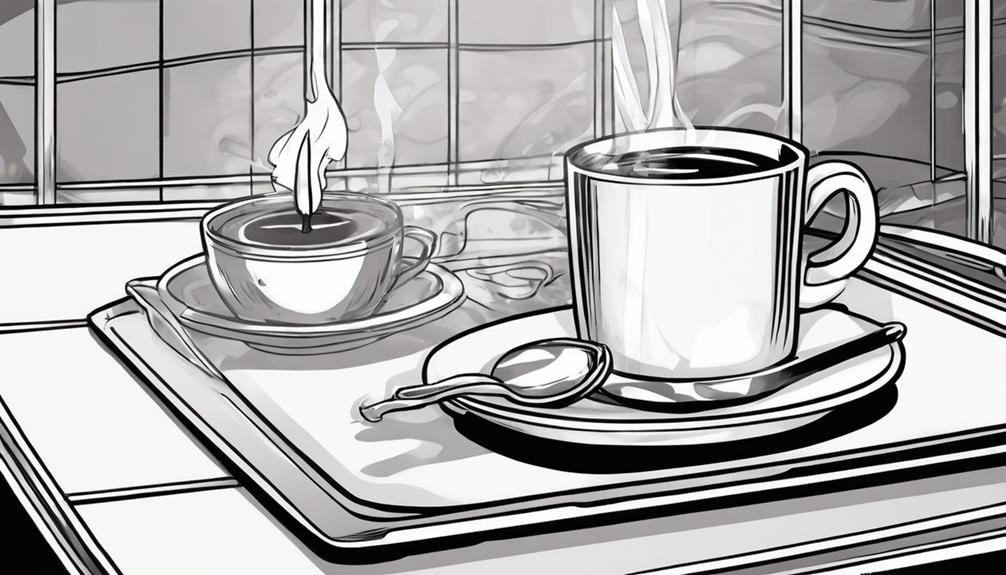
To effectively control pests using burning coffee grounds, strategically place them near windows to deter insects from entering your home.
Guarantee the smoke drifts towards you to repel pests effectively, covering the fire to enhance smoke production and insect control.
Strategic Smoke Placement
Positioning the burning coffee grounds strategically allows you to effectively repel insects by directing the smoke towards desired areas.
To maximize the benefits of strategic smoke placement for pest control, remember these key points:
- Think Ahead: Anticipate the direction of the wind to position the burning coffee grounds upwind and guarantee the smoke spreads effectively.
- Cover Up: Concealing the burning coffee grounds can boost smoke production, intensifying their pest-repelling properties.
- Window Wisdom: Placing the grounds near windows creates a barrier that deters insects from entering your space, enhancing your pest control efforts.
- Stay Alert: Never leave the burning coffee grounds unattended to prevent potential fire hazards and secure a safe pest control process.
Window Insect Deterrence
When deterring insects near windows using burning coffee grounds, remember to strategically position the fire to maximize the smoke's effectiveness in repelling pests.
Placing burnt coffee grounds near windows creates a natural barrier that discourages insects like flies and mosquitoes from entering your home.
To enhance the insect control near windows, cover the fire to increase smoke production, ensuring a more potent deterrent.
By positioning the burning grounds strategically, you can create a shield against unwanted pests, making your living space more comfortable.
Remember never to leave the burning coffee grounds unattended, especially when placed near windows, to prevent accidents.
Utilizing burnt coffee grounds for window insect deterrence is a cost-effective and eco-friendly way to keep pests at bay without the use of harmful chemicals.
Embrace this natural solution to enjoy a bug-free environment around your windows.
Coffee Grounds in Gardening
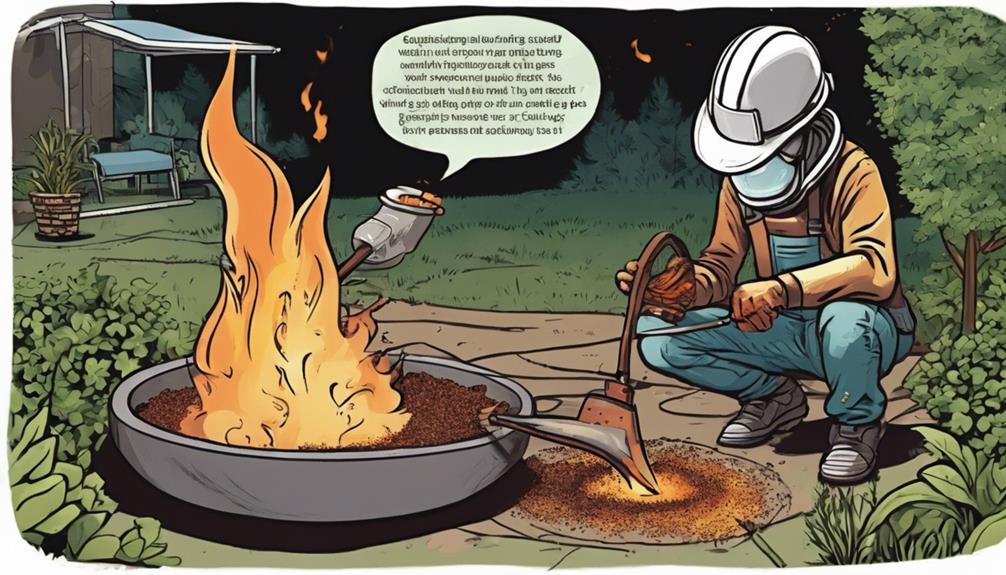
Using coffee grounds in gardening provides a natural and sustainable way to enhance soil quality and promote plant growth. The high nitrogen content in used coffee grounds acts as a natural fertilizer, enriching the soil and supporting plant growth.
Incorporating coffee grounds into compost piles not only boosts nutrient content but also aids in the healthy development of plants. By repurposing coffee grounds in the garden, you're engaging in an eco-friendly practice that benefits both your plants and the environment.
Moreover, the acidity of coffee grounds helps improve soil structure, creating a more favorable environment for plant roots to thrive. The natural insect-repelling properties of coffee grounds serve as a dual-purpose tool, protecting your garden from pests without the need for harmful chemicals.
Embrace the sustainable benefits of using coffee grounds in your gardening routine and watch your plants flourish organically.
Expert Advice on Coffee Ground Usage
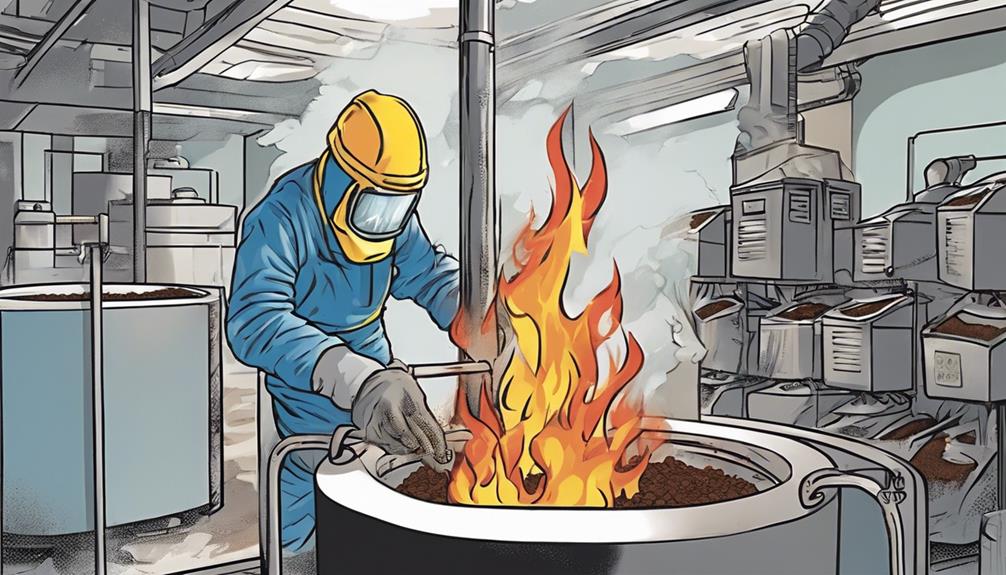
For expert guidance on maximizing the benefits of coffee grounds in gardening and pest control, consult with knowledgeable sources in the field. When it comes to utilizing burnt coffee grounds for pest control, it is crucial to seek advice from experts who understand the intricacies of using this method effectively. By consulting with professionals, you can learn how to strategically apply coffee grounds to naturally repel insects and pests in a safe and eco-friendly manner. Experimenting with different applications of burnt coffee grounds will help you optimize their effectiveness in gardening while being mindful of the benefits and limitations associated with this approach.
—
| Burnt Coffee Grounds Uses | Benefits |
|---|---|
| Pest Control | Natural repellent for insects |
| Gardening | Enhances soil quality |
Frequently Asked Questions
How to Safely Burn Coffee Grounds?
To safely burn coffee grounds, keep them away from open flames, maintain proper ventilation, use a heat-resistant container on a level surface, have a match ready, and supervise the process. Never leave it unattended to prevent accidents.
How Do You Burn Coffee to Keep Mosquitoes Away?
When keeping mosquitoes away, you burn coffee grounds to create a smoky barrier. Dry them, light them up with a wick or lighter fluid, and position strategically. Coffee's caffeine and diterpenes act as natural insecticides.
Can You Burn Coffee to Get Rid of Wasps?
Yes, you can burn coffee to repel wasps. The strong aroma and smoke from burning coffee grounds deter wasps effectively. Position the burning coffee strategically to keep wasps away from outdoor areas, offering an eco-friendly pest control method.
Can You Throw Coffee Grounds in the Fire?
Imagine the flames dancing as you toss coffee grounds into the fire. Guarantee they're dry to prevent smoke. A unique aroma fills the air. Use a safe container or pit to contain the flames. Enjoy the show!
Conclusion
To sum up, burning coffee grounds can be a safe and effective way to repel pests, enhance gardens, and even improve fire safety.
By following proper precautions and expert advice, you can make the most out of this versatile material.
Remember to always prioritize safety, proper ventilation, and strategic placement when using coffee grounds for various purposes.
So go ahead, burn those coffee grounds and see the benefits for yourself!


